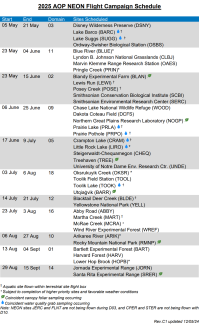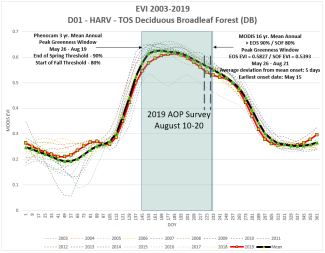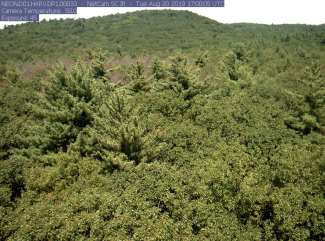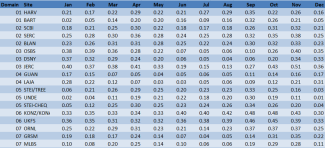Flight Schedules and Coverage
The goal of NEON's airborne remote sensing program is to acquire airborne lidar and hyperspectral data capable of producing consistent, quantitative measurements spanning multiple years.
At each terrestrial site a minimum of 100 km2 is surveyed over an area encompassing the NEON flux tower airsheds and distributed long-term observational sampling plots, representative vegetation types, and watershed boundaries for both terrestrial and aquatic sites. The NEON flight season typically runs from March to October each year. Remote sensing data are collected over aquatic and terrestrial field sites during peak greenness. Collection of AOP data is also synchronized with data collected on the ground at each site. This allows scientists to develop a more comprehensive picture of how different observations scale and how measurements taken from airborne remote sensing instruments correlate with observations made on the ground.
Current and Past Schedules
NEON Leadership is continually assessing conditions across the Observatory and may reinstate closures if local conditions dictate. For this reason, the AOP flight schedule is tentative and subject to change without notice. Please review the Observatory Status Page or contact NEON for the latest information on the 2025 schedule.
The 2025 AOP flight schedule is posted below.
While preliminary data collection started in 2013, the standard schedule for full operations of the AOP began in 2018. Under the current plan, data are collected annually at field sites in the continental U.S. and Alaska at a minimum of three out of every five years, and in Puerto Rico and Hawaii every five years. The data are processed after each survey and made available - including dates of acquisition - via the NEON data portal.
Current Schedule
2025 Flight Schedule - Payloads 2&3

If you are interested in tracking the 2025 season, sign up to receive daily flight report emails by NEON Domain or visit our flight report archive. Please note, you will only receive emails during the time period the AOP is in the Domain you have signed up to follow.
Past Schedules
The CSV file below contains the flight dates for all of the previous AOP site visits. (2024 coming soon)
Download AOP Flight Dates 2013-2023 CSV
Viewing and Accessing Flight Boxes
Flight boxes can be viewed in the field site map on the Explore Field Sites webpage. To download the flight boxes, visit the Spatial Data & Maps webpage, where polygon flight boxes can be downloaded as a shapefile or KMZ file. These files include flight boundaries for aquatic and terrestrial field sites at all sites in NEON Domains D01 to D19. Please note that flight boundaries may change from year to year. Contact us for the most current plans and to coordinate research activities on the ground.
How Flights Are Scheduled
The interannual flight schedule is primarily constrained by the phenology of vegetation at each site and typical patterns of cloud cover during different months of the year. NEON performs surveys when the dominant plant species at a site are at or near peak foliar growth ("greenness") so that estimates of leaf area, foliar biomass, gas exchange, etc. are accurate and comparable over time. NEON also attempts to perform surveys when atmospheric conditions are cloud-free. Atmospheric conditions greatly influence the quality of data produced by the spectrometer. Accurately characterizing clouds and aerosols within the atmosphere during flight—and then representing these within radiative transfer models used for the retrieval of surface spectral reflectance—is a major challenge. Clouds often interfere with the acquisition of land surface data, and even when they are not optically thick enough to significantly diminish the signal, they may introduce errors in data that are difficult to remove through modeling alone.
Surveying During Peak Greenness
In an effort to minimize variability in spectral reflectance retrievals among data sets collected over multiple years and control for variation in the phenological cycle, AOP flight campaigns are scheduled to take place during peak vegetation greenness, at solar elevation angles greater than 40 degrees and when cloud cover represents less than 10% of sky coverage. For each NEON site, time series of 8-day composite enhanced vegetation indices (EVI) from the MODIS sensor onboard NASA's Terra and Aqua satellites are processed for major vegetation types within each site's terrestrial observation (TOS) sampling boundary and AOP Priority 1 flight box. Peak greenness periods for each vegetation class are determined by identifying end-of-spring (>90%) and start-of-fall (>90% or 80%, depending on vegetation type) phenophase transition dates in the EVI time series (Figure 1).

Mean and annual peak greenness periods for deciduous broadleaf vegetation at Harvard Forest (HARV), with 2019 AOP survey dates.
Tower-based phenocam images (Figure 2) are then used to generate phenophase transition dates for validation of satellite-based EVI peak greenness measurements in areas characterized by similar vegetation.

Phenocam image showing the condition of foliage during the last AOP survey date at HARV in 2019.
Inter-annual variability in the timing of end-of-spring and start-of-fall peak-greenness is biome-specific. Deciduous broadleaf forests, evergreen needle forests, and tundra are relatively consistent year-to-year because green-up and senescence are linked to broad-scale seasonal changes in temperature and precipitation; grasslands and savannas are highly variable, with green-up mainly driven by individual rainfall events. Agricultural sites are also variable due to cropping practices that tend to track short-term climate trends. Within a given flight box there may be multiple, asynchronous peak greenness periods for different vegetation types, which can make flight scheduling a challenge. Therefore, the dates corresponding to the mean peak greenness period for dominant vegetation are used to determine the acceptable survey dates at a given site, and adjustments are then made based on the phenology of secondary vegetation types.
Cloud-free Data Collection
To calculate the number of days required to collect cloud-free data at each site within its peak greenness period, cloud cover percentages are derived for each flight box from a time series of daily MODIS data, from which the mean number of cloud-free days per month are calculated (Figure 3). Monte Carlo simulation is then used to determine the probabilities that flights of specific durations will result in cloud-free data acquisitions during the months of the year coinciding with each site's peak greenness period. For sites where field-based canopy foliar sampling is planned, cloud-free collection probabilities are set to 90% confidence, while sites without foliar sampling are set to 60% confidence. This results in flight deployment windows for all sites scheduled to be flown in a given year, which are assembled into an optimized flight campaign schedule that maximizes the likelihood of cloud-free data collection during peak greenness, while minimizing transit time between Domains.

Figure 3 - Percent of days each month with <10% cloud cover over NEON AOP priority 1 flight boxes.
Relevant Publications:
Spanning scales: The airborne spatial and temporal sampling design of the National Ecological Observatory Network. Musinsky, J., Goulden, T., Wirth, G., Leisso, N., Krause, K., Haynes, M., & Chapman, C. (2022). Methods in Ecology and Evolution, 13(9), 1866–1884. https://doi.org/10.1111/2041-210X.13942
Search publications using NEON AOP data in our curated Zotero library, or by using keywords (e.g., lidar, AOP) in our NEON Dimensions page.